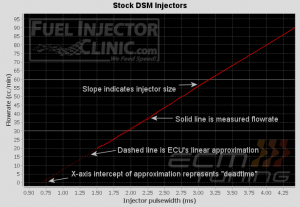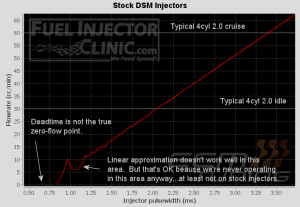Table of Contents
Injector data - Overview
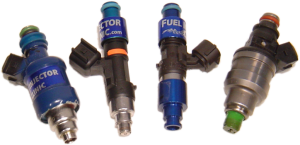 Injectors are thought of as simple devices. You grab a set of XYZ injectors off someone's website, adjust your global fuel scale and deadtime tables based on what they told you the injectors flowed and drive off.
Injectors are thought of as simple devices. You grab a set of XYZ injectors off someone's website, adjust your global fuel scale and deadtime tables based on what they told you the injectors flowed and drive off.
But if you've actually tried this, you probably already know it doesn't always work out that way.
This page is intended to explain why it's just not that easy and to explain why the services we provide can help, at least a little bit and at least with Mitsubishi ECUs.
It's also intended as a reality check to some extent as to what's physically possible and what's not.
ECMTuning services
History
We've spent the better part of a year developing a new type of test stand and control software. This is all 100% custom work using our own low-level device code and laptop control software. With this stand we've been able to test a huge number of different scenarios and combinations that were previously not possible simply because of the time required to do them.
We've worked closely with Fuel Injector Clinic getting a variety of different injectors to test with and bouncing ideas back and forth. So we have a huge collection of data involving a large number of injectors, fuel types, battery voltages, driver types, etc.
Mitsubishi focus
Our primary focus is on the Mitsubishi ECUs. We're uniquely positioned to provide data to the Mitsubishi guys (DSMs, EVOs, 3G Eclipses, etc.) because we're the only company we're aware of that has built an entire test stand around these ECUs. And, yes, the specific details about the injector driver circuit you use for testing does matter. See below for more details or click here.
We can test with peak/hold drivers if you want (it's a simple plug-and-play effort on our stand), but our default is to use factory Mitsubishi ECU drivers in all our tests. So the numbers we come up with are as directly related to these ECUs as you can get.
End goals
Our goal is to provide customers with a new level of service that simply wasn't possible before. We built our test stand and developed our software around this one key goal. We want to get you data that is as relevant to your specific configuration as we can.
What are "the numbers"?
Let's start with a quick explanation of “the numbers”. Most factory ECUs model injector flow as a simple linear (straight line) approximation. If we plot out the measured flow rate of a stock set of DSM injectors and then show the linear approximation on top of it, you'll see why. The two line up extremely well.
The slope of this line indicates basic injector flow rate. Larger injectors will have a steeper slope. Meaning you get a larger increase in flowrate (y-axis or “rise”) for each increase in injector pulsewidth (x-axis or “run”).
Where this approximation line crosses the x-axis is what we call “deadtime”. That's the point of estimated “zero” flow (y-axis value of 0 cc/min).
It gets tricky, though, because this “deadtime” number is entirely abstract. It doesn't really represent the zero flow point of the injector. It's just the offset used to make the approximation line a “best fit” to the measured data. The image below illustrates this idea.
Getting the right numbers
Flow testing injectors is not easy. Well, it's easy to grab basic flow data and post it up. But it's not easy to drill down into the details that really affect idle and part throttle driveability and figuring out why one set of injectors on one car seems to behave so different than another set of the same type of injectors on another car.
Nobody in the aftermarket community does this right for everyone and we're not claiming to be the exception. The whole problem is just too large and the operating environment (your car) is just too uncontrolled.
The best we can do here is to explain many of the things that make the process difficult and to explain what we do above and beyond anyone else to get you a lot closer out of the gate.
First, let's review some of the things that make getting exact numbers for your exact situation really hard.
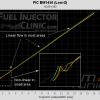 | Low pulsewidth variation from one injector to the next is common (click to read) |
 | Different injector driver circuits produce different results (click to read) |
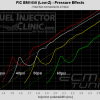 | Fuel pressure affects deadtime as much as flow rate (click to read) |
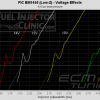 | Voltage offset tables need to be customized (click to read) |
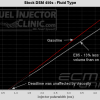 | Even fluid properties play a role (click to read) |
Real world advice
OK, so injector flow is not simple after all. And even with careful measurements on a stand, unless you *know* the exact fluid properties of your fuel and you know that the stand was using the same driver as your ECU and you get all the data related to voltage offsets and fuel pressure effects, your personal results are still going to vary a bit.
So what can you do about it? Well, you need to try to control those variables as best you can. And that starts with getting as much data as you can about the injectors you're buying.
- Ask that your injectors be flow matched in the areas where you're actually going to run them. This will depend on which injectors you're getting and which fuel you're going to run as well as your engine's displacement and number of cylinders. It also depends on whether you're going to run a peak/hold driver or a stock ECU driver. The place you're getting your injectors from needs to be able to answer these questions and provide you with numbers that relate (as best as they can) to your particular setup.
- If part throttle driveability is critical for you, ask that your injectors be matched in these areas. Doing so will surely involved more testing time (low flow testing takes a LOT of time) and may incur some additional charges as a result. But getting injectors matched in the areas where they're going to be used 99% of the time can make the difference between having a set of injectors you're happy with vs. having a set you can't stand on a daily basis.
- Get voltage offset data related to the driver type you're using. Having a general voltage offset curve for your driver type combined with your injector type helps to keep the relative swings in deadtime in check when voltage suddenly drops because the fans kicked on or you're trying to start your engine in -20F temps.
- Above all else, use the knowledge you have now about all the things that affect injector flow rate and apply it to your situation. If you know you're changing fuel type from gasoline to E85, expect to need to add a little more fuel than the stoichiometric calculation alone suggests (yes, that means your 1450s might be flowing only 1300 cc/min on E85). Understand the difference between deadtime and flowrate and where each has a major impact (deadtime on idle/cruise and base flowrate on WOT performance). Order injectors that make sense for your specific application and usage. No matter how much testing you do, not every set will drop into every car and work perfectly. It's all about matching the injectors with your situation.
